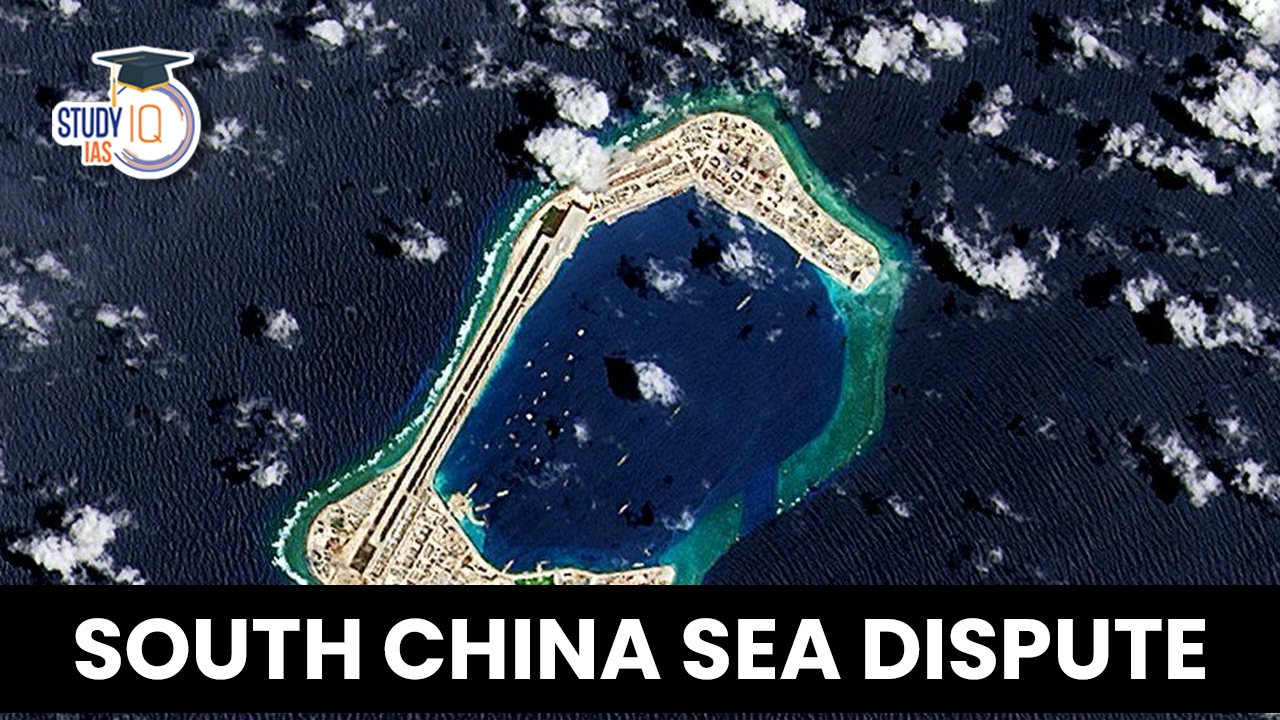Table of Contents
Context: A fresh dispute broke out between China and the Philippines recently after China installed a barricade near the South China Sea’s Scarborough Shoal.
About the Scarborough Shoal
- Scarborough Shoal is a triangle-shaped atoll located in the South China Sea, approximately 120 nautical miles west of the Philippine island of Luzon.
- It lies within the Philippines’ exclusive economic zone (EEZ). However, the shoal is also claimed by China through the disputed nine-dash line.
- The shoal is a rich fishing ground and is also believed to be rich in oil and gas reserves. It is also located near strategic shipping lanes, making it a valuable piece of territory.

Understanding South China Sea Dispute
About the South China Sea:
- It is a marginal sea of the Western Pacific Ocean.
- A marginal sea is a type of sea that is partially enclosed by land and connected to a larger ocean or sea.
- The South China Sea is connected by Taiwan Strait with the East China Sea and by Luzon Strait with the Philippine Sea.
- Bordering states & territories (clockwise from north): The People’s Republic of China, the Republic of China (Taiwan), the Philippines, Malaysia, Brunei, Indonesia, Singapore and Vietnam.
- The Gulf of Thailand and the Gulf of Tonkin are also part of the South China Sea.
Significance of the South China Sea
- Strategic Location: It is strategically located at the crossroads of major maritime trade routes, connecting the Pacific Ocean to the Indian Ocean.
- It serves as a crucial transit point for international shipping, and global trade.
- According to the UNCTAD, one-third of the global shipping passes through it.
- Natural Resources: The sea is believed to have abundant natural resources, including fisheries and potential oil and gas reserves.
- More than half of the world’s fishing vessels are in the South China Sea, and millions of people depend on these waters for their food and livelihoods.
- Territorial disputes: The South China Sea is the subject of territorial disputes between several countries, including China, Vietnam, the Philippines, Malaysia, Brunei, and Indonesia. These disputes have led to tensions and instability in the region.
Evolution of the Conflict over the South China Sea
- The evolution of the South China Sea conflict can be traced back to the mid-20th century when China laid its claim to the region.
- In 1947, China published a map with a nine-dash line, claiming most of the South China Sea.
- The nine-dash line, also referred to as the eleven-dash line by Taiwan, is a set of line segments on various maps that accompanied the claims of the People’s Republic of China and the Republic of China in the South China Sea. (see the map given above).
- The United Nations Convention on the Law of the Sea (UNCLOS) came into force in 1994, providing a legal framework for balancing the interests of coastal states and seafaring nations.
- While most coastal countries in the South China Sea signed and ratified UNCLOS, each country interpreted the convention to legitimize their own claims, leading to ongoing tensions.
- In 2002, the Association of Southeast Asian Nations (ASEAN) and China signed the Declaration on the Code of Conduct of Parties in the South China Sea in an attempt to manage and resolve disputes.
- The Philippines and China had conflicting claims over the Scarborough Shoal. A standoff in 2012 resulted in China gaining de facto control over the region.
- In 2013, the Philippines brought the dispute with China to the Permanent Court of Arbitration (PCA), asserting that China’s claims violated its sovereignty under UNCLOS.
- The PCA Ruling:
- The PCA ruled in 2016 that China’s claims over 90 percent of the South China Sea were illegitimate.
- It also concluded that China was infringing on the Philippines’ sovereign waters by including the Scarborough Shoal within its nine-dash line, which extended into the Philippines’ Exclusive Economic Zone (EEZ).
- China rejected the PCA ruling, asserting that it has historical rights to the South China Sea and prefers bilateral negotiations with other parties involved.
- However, the dispute remains unresolved, and tensions continue to exist in the region.
- Since then, tensions between China and the Philippines, as well as other countries in the region, have escalated.
- China has been increasing its assertiveness in the South China Sea, leading to conflicts and disputes over maritime boundaries, fishing rights, resource exploration, and freedom of navigation.
Several Claims over the South China Sea
| China | China claims nearly the entire South China Sea based on its historical “nine-dash line” claim, which encompasses the Paracel Islands, Spratly Islands, Scarborough Shoal, and other features within the region. |
| Taiwan | Taiwan, officially known as the Republic of China (ROC), asserts the same territorial claims as China over the South China Sea, including the Paracel Islands, Spratly Islands, and Scarborough Shoal. |
| Vietnam | Vietnam claims sovereignty over the Paracel Islands and the Spratly Islands in the South China Sea. |
| Philippines | The Philippines asserts its claims over the Spratly Islands, including Scarborough Shoal, which is located within its Exclusive Economic Zone (EEZ). |
| Malaysia | Malaysia claims several features in the Spratly Islands, including the Layang-Layang Reef, Swallow Reef, and the Investigator Shoal. |
| Brunei | Brunei claims a portion of the Spratly Islands, but its claim is relatively small compared to other claimant countries. |


 TALASH Initiative: Objective, Key Featur...
TALASH Initiative: Objective, Key Featur...
 Custodial Deaths in India, Types, Issues...
Custodial Deaths in India, Types, Issues...
 MPPSC FSO Recruitment Notification 2025 ...
MPPSC FSO Recruitment Notification 2025 ...





















